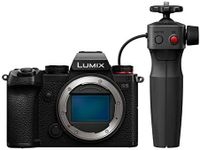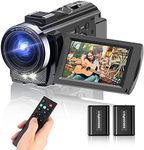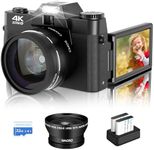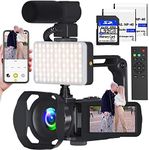Buying Guide for the Best Budget Video Cameras
When choosing a budget video camera, it's important to focus on the features that will best suit your filming needs. Whether you're capturing family moments, creating content for social media, or starting a small video project, understanding the key specifications will help you make an informed decision. Consider what you'll be filming, where you'll be filming, and how you'll be using the footage. This will guide you in selecting a camera that balances quality, usability, and affordability.ResolutionResolution refers to the number of pixels that make up the video image, typically measured in terms of width x height (e.g., 1920x1080 for Full HD). Higher resolution means more detail and clarity in the video. Common resolutions include 720p (HD), 1080p (Full HD), and 4K (Ultra HD). If you're filming for online platforms or personal use, 1080p is usually sufficient. However, if you want more detail or plan to edit heavily, consider 4K. Choose based on your need for detail and the capabilities of your playback devices.
Frame RateFrame rate is the number of frames captured per second, expressed in frames per second (fps). Common frame rates are 24fps, 30fps, and 60fps. A higher frame rate can capture smoother motion, which is important for fast-moving subjects or slow-motion effects. For standard video, 30fps is typically adequate. If you plan to shoot action scenes or want to experiment with slow motion, look for cameras that offer 60fps or higher.
Sensor SizeThe sensor size affects the camera's ability to capture light and detail. Larger sensors generally provide better image quality, especially in low light. Common sensor sizes in budget cameras include 1/2.3-inch and 1-inch. If you often shoot in low-light conditions or want a more cinematic look, opt for a larger sensor. For general use, a smaller sensor may suffice and keep the camera more compact.
Zoom CapabilityZoom capability allows you to get closer to your subject without physically moving. Optical zoom uses the camera's lens to magnify the image, maintaining quality, while digital zoom enlarges the image digitally, often reducing quality. Look for a camera with a good optical zoom range if you plan to shoot subjects from a distance, such as wildlife or sports. For everyday use, a moderate zoom range is usually enough.
StabilizationImage stabilization helps reduce blurriness caused by camera shake, which is especially useful when shooting handheld or on the move. There are two main types: optical and digital stabilization. Optical stabilization is generally more effective as it physically adjusts the lens or sensor. If you plan to shoot a lot of handheld footage or action shots, prioritize a camera with good stabilization features.
Audio QualityAudio quality is crucial if your videos include dialogue or ambient sound. Built-in microphones vary in quality, and some cameras offer external microphone inputs for better sound capture. If audio is important for your projects, consider a camera with a good built-in mic or the ability to connect an external mic. For basic home videos, the built-in mic may be sufficient.
Battery LifeBattery life determines how long you can record before needing to recharge or replace the battery. Longer battery life is beneficial for extended shoots or when access to power is limited. Consider how long your typical shooting sessions are and whether you have the option to carry spare batteries. For frequent or long-duration filming, prioritize a camera with a longer battery life or the ability to swap batteries easily.








